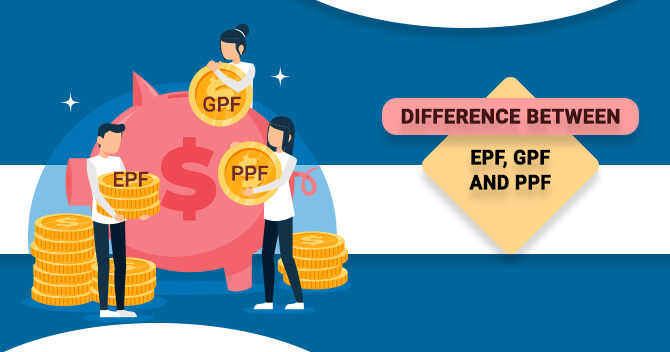Provident fund is a speculation store that is willfully settled by managers and workers to act as long haul investment funds to help a people’s retirement. There are different kinds of Provident funds which are utilized by associations to determine retirement benefits for the workers like Employee Provident fund (EPF), Public Provident fund (PPF) and General Provident fund (GPF).
Here are the distinctions and advantages of each Provident fund:
1.Employee Provident fund (EPF):
EPF benefits are given to representatives of an association. For representatives with a base pay of up to Rs 15,000 every month to get retirement benefits, confidential area organizations with in excess of 20 workers are expected to embrace EPF. For workers procuring a higher base compensation, it is a discretionary advantage.
A business contributes 12% of his/her essential compensation and the business makes a matching commitment. A representative might decide to build their commitment level above 12%.
Advantages of EPF:
Singular amount PF withdrawal at the hour of retirement
Standard benefits under Workers’ Annuity Plan (EPS)
Protection benefit under Employees’ Deposit Linked Insurance (EDLI)
Out of the business’ 12% commitment, 8.33% goes to EPS and rest goes to EDLI while the representatives’ 12% commitment goes to EPF.
After talking with the government the pace of interest is pronounced by the Employee Provident fund Organization (EPFO). The rate in contrast with the other two Provident funds are higher.
Business’ whole matching commitment up to 12 percent of the essential (Basic+DA) pay is tax exempt.
- Public Provident fund (PPF):
As the name recommends, everybody can get to this asset, whether they are in the military, an entrepreneur, an expert, or independently employed. Anybody with a PAN is qualified to enroll a PPF represent themselves and their minor youngsters, and they are permitted to store up to Rs 1.5 lakh altogether across all accounts opened involving their PAN in a given financial year. A PPF account has a 15-year maturity period, which might be over and over stretched out for blocks of 5 years at maturity.
Advantages of PPF:
Government proclaims the pace of PPF on a quarterly premise and it is by and large kept higher than the predominant fixed deposit rates.
An account holder might pull out the whole sum in single amount or may broaden the record for an additional 5 years regardless of commitment, on development.
From the third to the 6th year, a PPF account holder might get against the store, and fractional withdrawals are allowed once the 6th year is finished.
- General Provident fund(GPF):
Government representatives who started working for the public authority prior to December 31, 2003 and who are getting annuity installments under the Old Benefits Plan (Operations) for developing their retirement corpus are qualified for GPF. Government representatives who qualify may contribute as much as 100 percent of their pay rates, with a base commitment of 6%.
Just workers add to GPF very much like PPF, however the contrast between them is that GPF isn’t accessible to the overall population and as far as possible has now been set at Rs 5 lakh in a monetary year.
Advantages of GPF:
Interest in GPF is absolutely protected and the pace of revenue offered is more than the predominant FD rates.
At the hour of retirement, cash that has collected in the GPF might be removed as a protuberance sum. For specific purposes, halfway withdrawal choices are accessible.
























